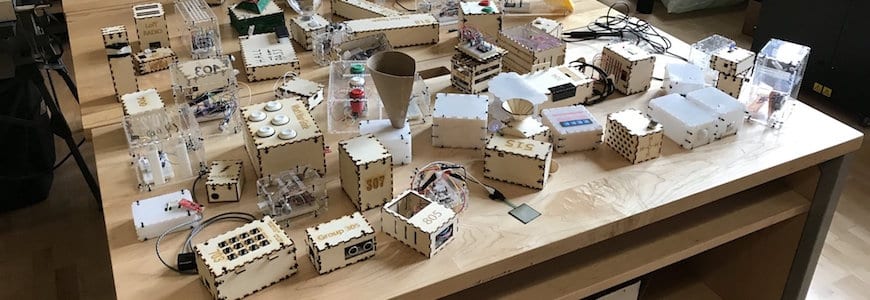By Rob Mitchum // May 3, 2017
The modern “shop class” is no longer the bandsaws and sandpaper of the old days. High school students today learn how to use high-tech instruments such as 3D printers and laser cutters, how to solder computer boards with sensors, lights, and processors, and how to write the code that makes these creations work. The best projects give students a chance to apply all these skills to a device of their own invention, giving them valuable experience in digital design and manufacturing.
For the second year running, Array of Things worked with Chicago’s Lane Tech High School on a workshop curriculum called “Lane of Things.” Over eight weeks, students in Lane Tech’s Innovation and Creation Lab and Physical Computing Lab worked with scientists and designers from the Array of Things project on designing and building their own sensor boxes. Teams then deployed those boxes around the school, collecting data on foot traffic, air quality, noise, student behavior, and more.
On April 24th, 55 teams set up in the Lane Tech cafeteria for demonstrations of their devices and results. Students talked about how they used their sensor boxes to help care for plants, keep track of bathroom passes, find the best time to visit the counselor, and many other innovative daily uses. Below, read about some of the projects from Lane of Things 2017.

Smart Plants
Lane Tech features both a roof greenhouse and an aquaponics laboratory, run by students and staff. Several groups decided to design sensor boxes that could help the school’s horticulturists monitor their plants’ health and apply the appropriate care. Gabriel Flores and Shahkruh Khan designed a box that monitored soil moisture, temperature, and humidity in a wandering jew plant kept in the greenhouse, with a red light activating when it needs watering. Daniel Quinones, Laura Mock, and Aschalw Ayele built sensors for the fishtank of the aquaponics lab, testing the temperature and pH of their water and signaling through a cloud-shaped screen when the water became too basic or acidic.

Classroom Life
High school means a lot of sitting around classrooms, and many projects looked at whether that environment is as healthy as possible. Different teams used dust sensors in combination with other devices to measure air quality, whether near the bandsaw machines in the robotics lab, or by the entrance to the aquaponics lab as students entered the room. Other teams tested noise pollution, using microphones to detect sound levels in music or math classrooms. Both teams found that classroom volume increases after lunch, suggesting more restless students as the end of the day approaches.

Hallway Traffic
Lane Tech High School is the size of a small college campus, with over 4,200 students enrolled. Determining the best time to visit administrative offices can save valuable time during the day for students, which motivated students to mount activity tracking boxes in high-traffic locations. Interestingly, teams deployed different strategies to track how many people entered and left the rooms, including hypersonic sensors that transmit sound waves, light sensors that measure the distance to the nearest object, and “trip wire” boxes that send a beam from one box to a second and count whenever the connection is broken.

Interactivity & Psychology
In addition to sensors that passively collect data, teams could also build in ways for students to interact with the boxes. The team of Sergio Cuenca, Lazar Gueorguiev, and Anthony Keung chose to look at why students left class, and how long they were away, and built in buttons for the most likely reasons to leave, such as bathroom, water, and teacher errands. Tomasz Hulka and Ari Greenberg — part of the team last year that built a “Don’t Touch This Button” box — created the “Frustrating Game” as a social experiment. Students inserted a coin to play a marble game, but the game was designed to freeze for 15 seconds before it started, and the box kept track of how many times the user hit the “reset” button to get their money back.
====

The distribution of sensors throughout Lane Tech High School. Graphic by Mark Satya Basu.
The broad range of projects on display demonstrated the potential of sensor technology to educate students about design, technology, fabrication, and science. With two years of experience, curriculum organizers Douglas Pancoast, Satya Mark Basu, Kate Kusiak Galvin, and Robb Drinkwater hope to expand the workshop to additional schools, in Chicago and beyond. An Array of Things sensor planned for a busy intersection near Lane Tech will also generate more data for students in the future to work with, in combination with their own sensor results.
Special thanks to Motorola Foundation, Lane Tech teachers Jeff Solin and Dan Law, the Lane Tech administration, and Particle for the donation of Photon kits.

